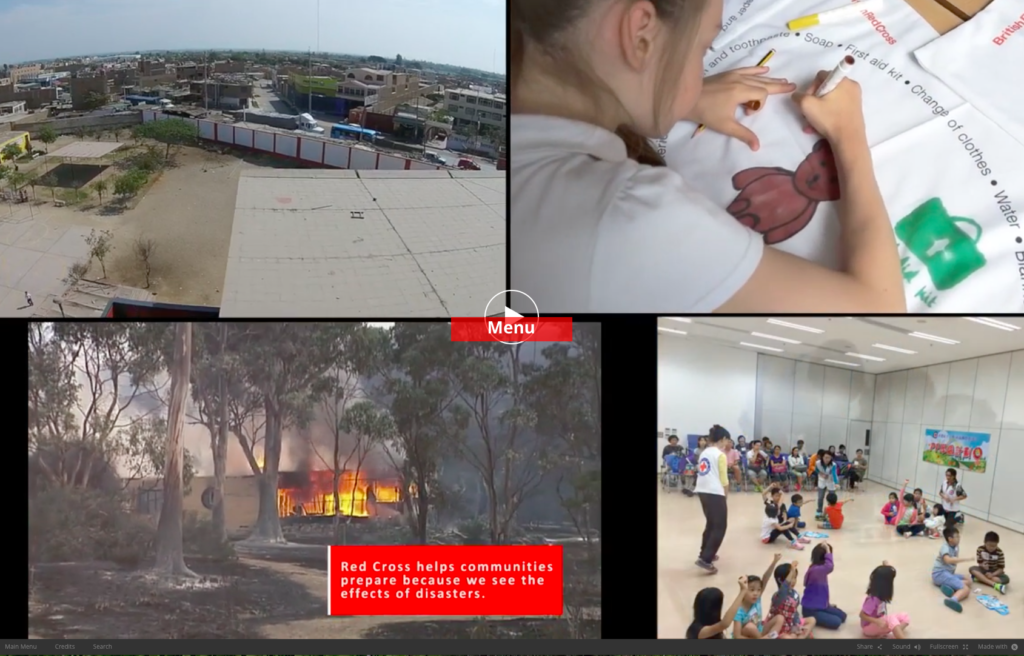global pillowcase project-idoc
Tag Archives: video
Pillow Case Project International Pilot Peru: Video Case Study
In December 2014 we went to Peru for American Red Cross/ Global Disaster Preparedness Center as part of the evaluation team. Purpose was to develop a knowledge-rich video case study about the adaptation, implementation and results of the Pillow Case Project in Peru for use by other Red Cross chapters in Peru as they scale up, as well as by other countries considering the project. Six countries were part of the initial international pilot funded by Disney with more than double that number of participating countries anticipated for 2015. The Video Case Study is intended to be an evaluation and knowledge management product that informs design and implementation from country to country. The opportunity exists to develop additional videos from all the footage we captured and interviews we conducted, more targeted for advocacy and communications. Quimera has also constructed the initial installments for a video-based KM archive for the project based on the raw footage collected in the field.
The inclusion of a video drone as part of the equipment mix was a first for Quimera, very exciting. Aerial footage of the the earthquake and tsunami affected communities offered a very powerful perspective and helped to provide important visual context to the project.
One again Taylor Krauss was part of the Quimera team, and brilliant as always.
Click here to watch the full length Video Case Study.
Global Disaster Preparedness Center: Video Case Study of Universal First Aid App
Disaster preparedness (DP) practitioners have expressed a growing interest in case studies as a way to learn, to better understand the challenges faced by their colleagues around the world as well as the innovative solutions developed to meet those challenges.
As part of GDPC’s efforts to support and facilitate the development of video case studies by Red Cross/Red Crescent societies and other DP practitioners Quimera worked with GDPC and the Argentinian Red Cross to help conceptualize, produce and edit the Universal First Aid App video case. Serving as a demonstration project, highlighting a “participatory video” or “DIY” approach, the video was filmed by team members from GDPC and Argentinian Red Cross on smartphones. Footage was then sent to Quimera for review and editing into a final case study. Quimera provided consulting, case development and technical support to GDPC and Argentinian Red Cross throughout the process.
The video provides an overview of the Program while offering insights into the work of the Argentinian Red Cross during the process of development and launch of the First Aid App in their country.
More broadly, Quimera has been working with GDPC to develop guidance and support that can assist DP practitioners to develop their own case studies, including case studies that integrate video and multimedia.
The Effectiveness of Video Messages in Public Health with High Risk Individuals
Community-based participatory research conducted in the Bronx, NY, drove the design of Project Three at Jacobi Medical Center in the Bronx. The project explores the effectiveness of video messages to re-engage high-risk individuals in HIV re-testinging as well as improve their knowledge of risk-reduction practices. Video messages were sent as text messages or emails, in Spanish or English, according to patient preferences. Based on a successful innovative video intervention model undertaken in Jacobi’s emergency department Quimera worked with Dr. Yvette Calderon and her team to help conceptualize, design and produce the video series.
This video offers some of Dr. Calderon’s thoughts about the importance of community-based participatory research along with a few snippets from the video message series.
Stay tuned for the results!
USAID/ GEM-3 Project Evaluation Video: What Can We Learn about the Evaluation Process
Quimera was embedded with the Social Impact evaluation team for over three weeks to document Social Impact’s evaluation of the USAID Philippines Growth with Equity in Mindanao-3 Project. GEM-3 operated throughout Mindanao, with a special focus on the Autonomous Region in Muslim Mindanao (ARMM) and other conflict-affected areas of Mindanao. USAID’s Office of Learning, Evaluation and Research (PPPL/LER) wanted to document the GEM-3 evaluation process as a way to capture evaluation in action, to support and illustrate their new evaluation policy, and to share learnings about what makes a good evaluation, from design to implementation.
In this short snippet one of the evaluation team members discusses some of the challenges of trying to quantify project impact.
To view the entire video click the sections below
Click here to watch Part 1: Framing the Evaluation.
Click here to watch Part 2: Data Collection.
Click here to watch Part 3: Final Thoughts.
US Department of State: Evaluation Training Video Components
Quimera worked with Social Impact to develop video components for SI’s evaluation training courses provided to the US Department of State, Designing Evaluation and Managing Evaluation. The footage used to create the videos was drawn from the USAID GEM-3 Project Evaluation Video, also developed by Social Impact and Quimera for USAID’s Office of Learning, Evaluation and Research (coming soon to USAID/ LER).
This snippet opens a section focusing on community interview techniques.
SAIS/ Johns Hopkins: Video in Practical Research Methods
Professor Raul Roman, also Co-Founder of UBELONG, has invited me in to his class on Research Methods for a number of semesters to discuss the use of video in qualitative research and evaluation. Here’s a video we did from the very first time I came to class… lots of fun, and the students were fantastic.

